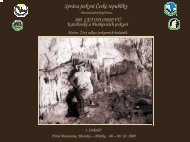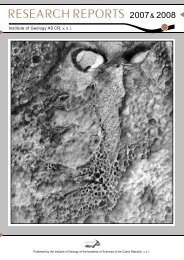triradiate locomotion Triadobatrachus evidenced segmentation
Get PDF (915K) - Wiley Online Library
Get PDF (915K) - Wiley Online Library
Create successful ePaper yourself
Turn your PDF publications into a flip-book with our unique Google optimized e-Paper software.
22 Development of the pelvic skeleton in frogs, H. RoCková and Z. RoCek<br />
arches may be recognizable as dorso-lateral extensions<br />
from the surface of the notochord). The neural arches<br />
grow towards each other below and above the spinal<br />
nerves, to make a posteriorly tapering structure pierced<br />
by one or more spinal foramina. Only later do the neural<br />
arches expand dorsally over the neural tube so that<br />
both halves gradually fuse together; simultaneously,<br />
the hypochord approaches their lateral sides because<br />
of reduction of the notochord, so that all these three<br />
elongated parts give rise to the urostyle. The urostyle<br />
of the adult retains its articulation (bicondylar, procoelous)<br />
with the sacral vertebra, and develops a pair of<br />
vestigial diapophyses declined posteriorly (Fig. 1G); a<br />
pair of spinal foramina is also preserved. The attachment<br />
of the urostyle to the sacral vertebra is movable<br />
in the adult.<br />
Bombina variegata and B. bombina<br />
Pelvic development in both European species of Bombina<br />
is similar to that in Discoglossus. The sacral neural<br />
arches appear at stages 51–53, and the earliest appearance<br />
of the 1st postsacral was recorded at stage 53. The<br />
very first rudiment of the pelvis is the ilium, which<br />
appears simultaneously (at stage 54) with the astragalus<br />
and calcaneus in both Bombina species (Figs 2H<br />
and 3D). It is located vertically, meeting the proximal<br />
end of the femur, which is in a horizontal position<br />
(Fig. 2H). Soon afterwards (stage 55), another chondrification<br />
centre appears below the proximal end of<br />
the femur (Fig. 3E) and fuses with the former (Fig. 3F);<br />
the latter may be identified as the ischium. Although the<br />
rate of development of the posterior limbs is similar to<br />
that in Discoglossus, development of the 2nd postsacral<br />
vertebra and of the hypochord is slightly delayed in<br />
Bombina. In addition, the hypochord appears at stages<br />
54–55, before the 2nd postsacral may be recognized<br />
(Fig. 2A,I,J,M). The shift of the anterior end of the<br />
hypochord towards the bases of the sacral neural<br />
arches (Fig. 2K) occurs at stage 60, because of gradual<br />
constriction of the notochord in an anterior–posterior<br />
direction.<br />
The iliac shafts reach the level of the notochord during<br />
stage 58 (Fig. 2J), when the 2nd caudal vertebra is<br />
still absent. They begin to rotate at stage 57, and their<br />
position at the end of metamorphosis (stage 66) is the<br />
same as in Discoglossus (Fig. 2L). The tips of the iliac<br />
shafts ultimately reach the level of the last presacral<br />
vertebra, and the line interconnecting both tips is<br />
approximately the axis of iliac rotation. In normal<br />
development the shafts adjoin the developing sacral<br />
transverse processes (whose development begins at<br />
stage 57) ventrally and, owing to the position of the<br />
rotation axis, the anterior ends of the shafts reach over<br />
the anterior margins of sacral diapophyses (Fig. 2P,S).<br />
However, there is some variation in the development<br />
of the ilio-sacral articulation, which may include, in<br />
addition to the sacral diapophysis, the transverse process<br />
of the most posterior presacral vertebra (Fig. 2N), or<br />
may entirely substitute the sacral diapophysis, which is<br />
not developed (Fig. 2Q). Nevertheless, in both species<br />
of Bombina, normal development results in a considerable<br />
shift of the pelvis anteriorly so that the tips of the<br />
ilia reach anteriorly beyond the level of the sacral vertebra<br />
(Fig. 2T), and sometimes even to the level of the<br />
second presacral vertebra (Figs 2S,T and 3N,P–R). Consequently,<br />
the postsacral part of the vertebral column<br />
located between both iliac shafts is relatively short and<br />
may be elongated by the inclusion of additional postsacral<br />
vertebrae (symmetrically or asymmetrically) so<br />
that in completely developed adults the anterior tips of<br />
the shafts extend only moderately over the sacral diapophyses<br />
(compare Fig. 3T with Fig. 2T).<br />
The pelvic development is completed (with the<br />
exception of the ilio-sacral articulation) as early as<br />
stage 58, before the front legs become apparent externally<br />
(Fig. 2B). There is, however, considerable variation<br />
in ossification degree: whereas in some individuals<br />
the ilia begin to ossify in very early stages (as early as<br />
stage 58; see Fig. 2J), the whole skeleton in others may<br />
remain cartilaginous even when their metamorphosis<br />
is completed (Fig. 2L).<br />
Bufo bufo<br />
The earliest rudiments of the pelvis appear at stage 54,<br />
as in Discoglossus. However, there is noticeable retardation<br />
in the development of the caudal skeleton,<br />
because neither the postsacral vertebrae nor the hypochord<br />
are developed at this stage (Fig. 4A). A short<br />
hypochord is present at stage 56 (Fig. 4F), but sometimes<br />
is still barely discernible (Fig. 4K). The ossification<br />
of the long bones starts as early as stage 57 (Fig. 4B,L),<br />
when cartilaginous neural arches of the 1st postsacral<br />
vertebra begin to develop. The neural arches of the 1st<br />
postsacral vertebra begin to ossify soon afterwards<br />
(stage 58), though before they fuse with one another<br />
above the neural tube (Fig. 4H,M). In addition, further<br />
© Anatomical Society of Great Britain and Ireland 2005





